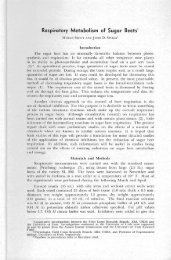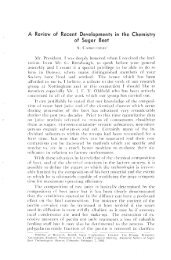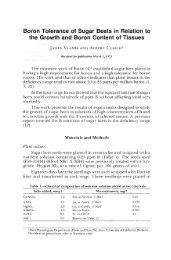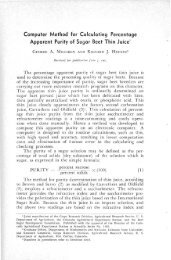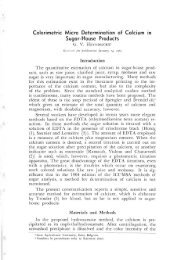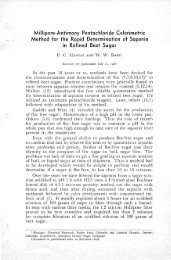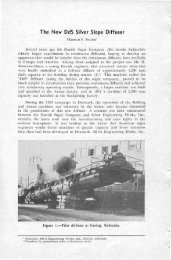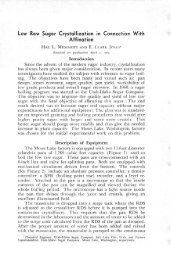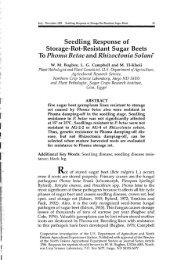Journal of Sugar Beet Research - Vol
Journal of Sugar Beet Research - Vol
Journal of Sugar Beet Research - Vol
You also want an ePaper? Increase the reach of your titles
YUMPU automatically turns print PDFs into web optimized ePapers that Google loves.
42 <strong>Journal</strong> <strong>of</strong> <strong>Sugar</strong> <strong>Beet</strong> <strong>Research</strong> <strong>Vol</strong>. 45 Nos. 1 & 2<br />
ments. In 2005 roots, HM PM21 lost more sucrose when untreated. In<br />
2006, Beta 8600 lost more sucrose when not treated, but the difference<br />
was not present in the 2005 roots. HH Phoenix R with Poncho Beta<br />
lost more sucrose than the other cultivars with Poncho Beta both years.<br />
When compared across cultivars, roots with Poncho Beta retained 8.5<br />
(P = 0.05) and 5% (P = 0.02) more sucrose in 2005 and 2006, respectively<br />
(Table 2). Regression analysis revealed a significant relationship<br />
between curly top ratings and sucrose reduction in both 2005 (r 2 = 0.28,<br />
P < 0.01) and 2006 (r 2 = 0.22, P = 0.02).<br />
DISCuSSIon<br />
Curly top <strong>of</strong> sugarbeet can lead to sucrose reduction in beet stored<br />
more than 100 days in outdoor piles. The Poncho Beta seed treatment<br />
reduced curly top symptoms in the field and subsequently was associated<br />
with reduced sucrose loss <strong>of</strong> 5 to 8% in long-term storage. The<br />
reduction in curly top symptoms associated with Poncho Beta had<br />
almost no measurable influence on surface rot, freeze damage, and<br />
weight loss in storage. Cultivar selection had a greater impact on storability<br />
and these data emphasize the importance <strong>of</strong> resistant cultivars in<br />
reducing storage losses.<br />
Recently, the influence <strong>of</strong> disease problems in the field have been<br />
studied using Rhizoctonia root rot (Kenter et al., 2006), Cercospora leaf<br />
spot (Kenter et al., 2006; Smith and Ruppel, 1971), Aphanomyces root<br />
rot (Campbell and Klotz, 2006), and rhizomania (Campbell et al., 2008;<br />
Strausbaugh et al., 2008). Based on these recent publications, it could<br />
be argued that some disease problems can rival if not exceed sucrose<br />
loss associated with inherent differences in respiration. The reduced<br />
sucrose loss in storage and reduction in symptoms associated with the<br />
Poncho Beta treatment suggest that curly top negatively influenced the<br />
storability <strong>of</strong> sugarbeet.<br />
Curly top on sugarbeet can be caused by BSCTV or two other closely<br />
related species <strong>Beet</strong> mild curly top virus [BMCTV] and <strong>Beet</strong> curly top<br />
virus [BCTV] (Stenger, 1998; Strausbaugh et. al., 2006). Surveys from<br />
plants in adjacent studies indicate that BSCTV and BMCTV were likely<br />
to have been present both years (Strausbaugh et al., unpublished data).<br />
BCTV was also likely to be present in 2006. A previous survey also<br />
established that BSCTV (formerly known as the CFH strain) was present<br />
in Idaho (Stenger and McMahon, 1997). Thus, the virus strains and<br />
disease pressure reported here should be typical <strong>of</strong> commercial fields<br />
under moderate curly top infestation.<br />
The clothianidin in Poncho is a second generation neonicotinoid



